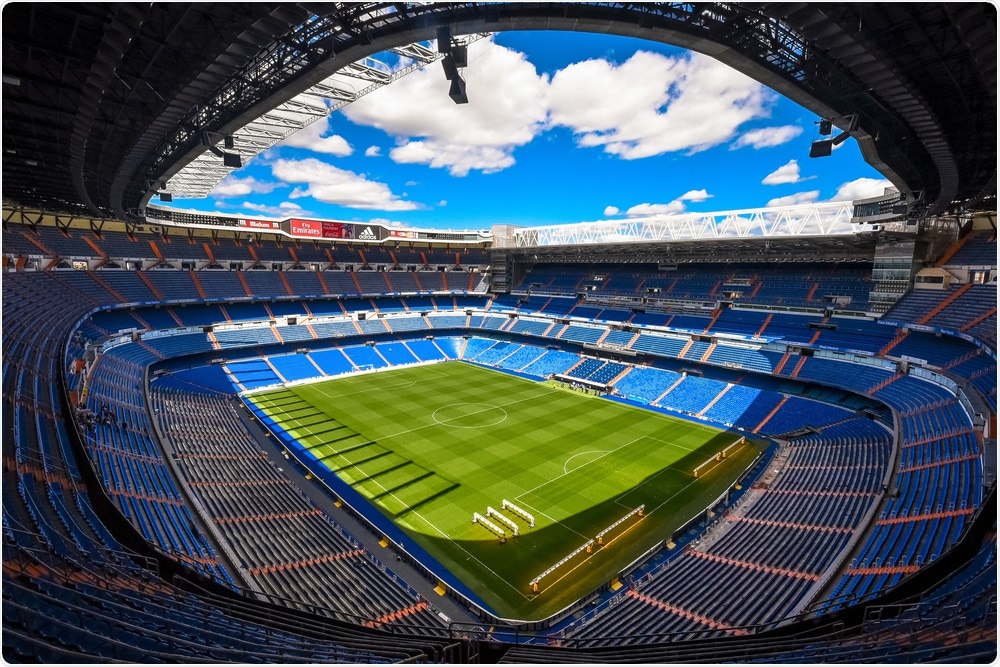The coronavirus disease (COVID-19) pandemic first emerged in Wuhan City, China, in December 2019. Since then, it has spread throughout the world, infecting more than 8 million people. Social distancing measures were imposed in most countries, isolating people in their homes, banning congregations, including schools, parties, and even sports events.
Many countries are slowly easing social and physical distancing measures. Now, the Spanish football league is coming back after three months of suspension due to the coronavirus pandemic.
A team of researchers at the Universidad Rey Juan Carlos, Madrid, Spain, used a modeling method to determine and describe COVID-19 propagation during a football match. This, they hope, will help design strategies to prevent the spread of the novel coronavirus, called severe acute respiratory syndrome coronavirus 2 (SARS-CoV-2), at sporting events.

Panoramic view of Santiago Bernabeu Stadium pitch. Image Credit: Jose Campos Rojas / Shutterstock J By
Opening the Spanish football league season
Spain has been one of the hardest-hit countries in the pandemic, with more than 244,000 infected and a death toll of at least 27,000 people.
Despite the coronavirus global health threat, Spain has decided to start its football league season but with virtual fans. The league also plans to conduct mass testing for all players throughout the season.
The first match was held on June 13, minus fans. However, during the match, a teenage male ran onto the field at Mallorca. Though fans are not allowed to watch the game, the teenager made it past security and took a photo of himself a few meters away from one of the players.
The teenager apprehended had no mask or gloves when he entered the field. The league will file criminal charges as the incident has jeopardized everyone’s health and the integrity of the competition.
Sports events modeling
Incidents just like this may occur during sports events, even without fans present. When a player gets infected with the coronavirus, there is a high chance he can transmit the virus to others.
In the study, which is published in the journal Chaos, Solitons & Fractals, the team used the SEIR model, which stands for Susceptible, Exposed, Infectious, and Recovered. The SEIR model describes the present condition of the player.
The SEIR model was first proposed in 1927 and was extensively used to describe the exponential growth of the number of people infected by SARS-CoV-2. It has also been utilized to describe the effects of quarantine and confinement measures and evaluate ways to reduce the risk of a second outbreak.
The model can be applied in sports events, like the Spanish football league, to describe the spread of the virus during a sports competition.
“The model, whose main parameters were based on the scientific literature concerning the infection and recovery periods of COVID-19, could be easily adapted to describe other kinds of sports competitions,” the researchers explained.
What the model suggests
The team suggests that players should be classified based on the SEIR model – susceptible, exposed, infected, and recovered. However, the team added two more classifications, quarantined and confined.
The modeling method has found that once a player gets infected, he or she has a probability of finishing the latent period and become infectious.
The model also accounted for the interaction dynamics of players, taking into consideration three different sources of infection – the player’s social circle, from the teammates during training, and the interaction with rivals during the match.
Hence, in case the player is infected with the virus, he will remain confined, and after confinement, he needs to undergo a quarantine period before being allowed to play again. Further, exposed and infected players will get tested to determine if they had been infected with the virus, and they will be confined in their homes.
Also, the researchers presented a variety of strategies to minimize infection risk in the competition.
“Our results highlight the influence of the days between matches, the frequency of virus tests, and their sensitivity on the number of players infected at the end of the season. Following our findings, we finally propose a variety of strategies to minimize the probability that COVID-19 propagates in case the season of La Liga was re-started after the current lockdown,” the researchers proposed.
The team suggested to increase player rotations to reduce the risk of injuries, and the organizers should perform mass testing. Moreover, the team said that if the players get infected, they can transmit the virus to others, like their families or social circle. It is recommended that players should reduce their contact with others, travel, public events, and limiting interactions with people outside the family.
The team also suggested that maintaining the players confined during the rest of the season is the optimal way to reduce the spread of the coronavirus.
“Finally, although the results shown here are focused on the resumption of the men’s Spanish national league, the conclusions are equally valid for the women’s competition. Furthermore, the model could be adapted to any competition in which matches involve some physical contact between players, such as basketball, handball or rugby,” the team concluded.
Sources:
Journal reference: